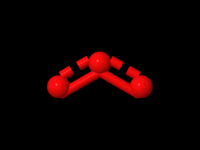Oxygen
Oxygen is an element that forms a diatomic gas (O2) under Earth's surface conditions. It also readily forms a triatomic molecule, known as ozone (O3), under some conditions such as electrical discharges. Ozone is more stable in the upper atmosphere and forms a barrier to ultraviolet energy, the ozone layer, which is very important to current life-forms on the planet.
This article is only a brief description of the subject and is not intended to give a full explanation.
Check out the "see also" or "references" sections, or Wikipedia's article for more detail.
| The poetry of reality Science |
| We must know. We will know. |
| A view from the shoulders of giants. |
v - t - e |
O2 is a highly reactive chemical, so much so that most chemical reactions are classed as "oxidation" or "reduction" reactions depending on the relative exchange of electrons involved. The process of oxidation is fascinating, with its results varying from forming a protective, non-oxidizing surface coating on aluminum, to slowly destroying artifacts made of iron ("rust"), to rapid processes we call combustion, which release large amounts of chemical energy in short periods of time.
Oxygen in its pure form is a useful industrial and medical commodity, and is often cooled and compressed into its liquid state for storage and transportation.
Shaping the earth
Earth's atmosphere is roughly 21% oxygen, which is created and replenished by plants using photosynthesis to capture energy from the sun. Most animal life depends on acquiring it via respiration, in order to use it in chemical reactions to obtain energy from food.
Oxygen-deprived regions are called "anoxic". Anaerobic bacteria are those which can survive only in environments in which there is no oxygen, and for which oxygen is toxic. It has been hypothesized that in order for life to form on earth, the entire atmosphere would have to be anaerobic, as oxygen would have caused the breakup of primitive organic chemicals as they first began to form. This is highly likely, since oxygen is a highly reactive element. The only reason we now have an atmosphere that is roughly one-fifth oxygen is the constant production of it as a waste product of photosynthesis. Note that when plants first evolved this process and started pumping O2 into the atmosphere, there was a mini-extinction event, known as the "Great Oxygenation Event
Oxygen caused exposed iron to rust as plants started to release it in photosynthesis.
Ozone

Ozone (O3) or "trioxygen", is a triatomic molecule consisting of three oxygen atoms. It is an allotrope of oxygen that is much less stable than the usual diatomic allotrope, O2.
Ozone in the lower atmosphere is an air pollutant with harmful effects on the respiratory systems of animals and will burn sensitive plants. The ozone layer in the upper atmosphere is beneficial, preventing potentially damaging ultraviolet light from reaching the Earth's surface. Ozone is present in low concentrations throughout the Earth's atmosphere and is the key component of most atmospheric chemistry.
Atmospheric ozone levels are one measure of air quality. In the 1950s, a Stage 1 Smog Alert occurred when the ozone level rose to 0.5 parts per million, and a Stage 2 Smog Alert was declared at 1 part per million of ozone. (Today, 0.5 ppm of ozone would qualify as a Stage 3 Smog Alert.)[1]
People in Victorian Britain would go to — indeed, were advised by physicians to go to — the seaside to "take the ozone". Fortunately, there's no more in sea air than there is anywhere else, or they'd have been coughing up blood. That characteristic seaside smell is dimethyl sulfide (C2H6S) derived from rotting seaweed.[2]
Health and danger
Just as with many other chemicals necessary for the continuance of healthy human life, some people are tempted to believe that "more is better". Hence the existence of "oxygen therapy". "More is better" is a harmless belief in the case of Vitamin C — excess intake (except in such grotesque proportions as to cause acidosis) will simply be flushed out — but in the case of oxygen, not so much. Oxygen, at high partial pressures, is a powerful cellular toxin due to the same strong reactivity that makes it such a vital chemical at lower partial pressures. (As toxicologists say, the dose makes the poison.)
Oxygen at high temperatures is extremely corrosive, causing fires with most substances. While it isn't flammable itself, oxygen in high concentrations makes many other things burn easily, even items which aren't normally burnable. The Apollo I fire occurred because the test on the pad was done in pure oxygen at sea level pressure (the Apollo missions were flown at 5-6psi; at that pressure, pure oxygen is no more dangerous than regular air).
A 2015 research paper found an association between increased lung cancer rates and higher levels of atmospheric oxygen associated with populations living at lower altitudes.[3][4] Of course correlation does not imply causation, but it does given one pause since oxygen is highly chemically reactive.
References
- http://latimesblogs.latimes.com/thedailymirror/2007/06/smog-alert.html
- The Telegraph, 2 February 2007
- More oxygen may lead to more tumors: Lung cancer risk drops at higher elevations where the air is thinner (Science News summary)
- Lung cancer incidence decreases with elevation: evidence for oxygen as an inhaled carcinogen by K. P. Simeonov and D. S. Himmelstein, PeerJ. Vol. 2, January 13, 2015, p. e705. doi:10.7717/peerj.705